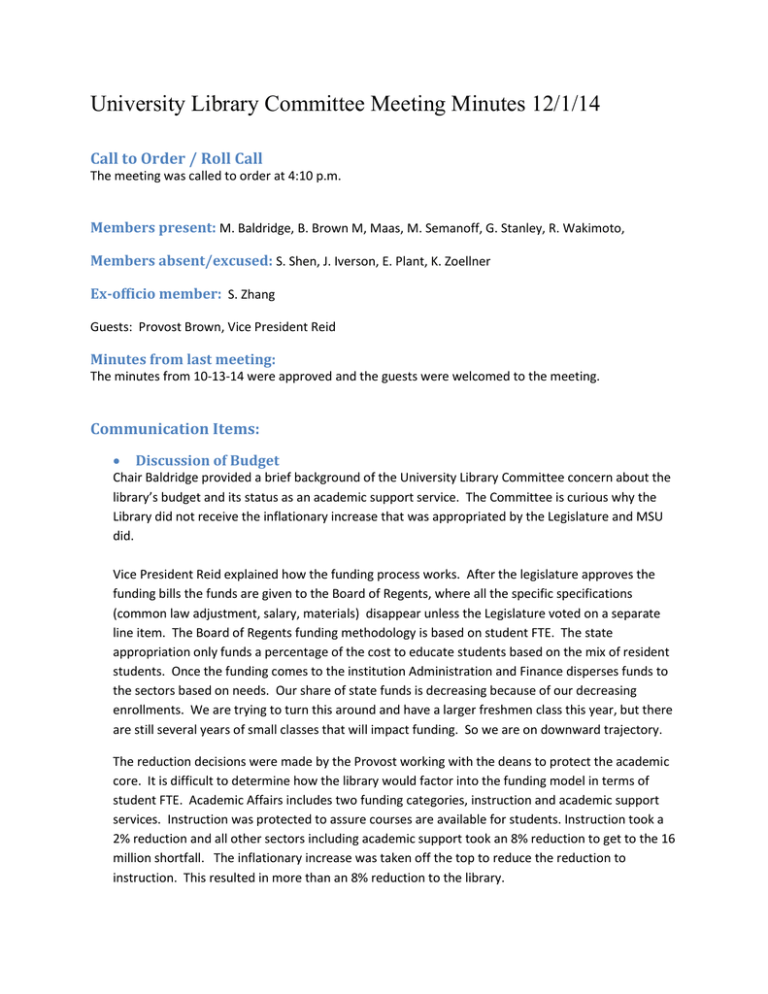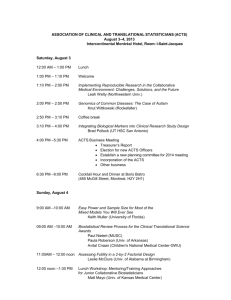University Library Committee Meeting Minutes 12/1/14 Members present:
advertisement

University Library Committee Meeting Minutes 12/1/14 Call to Order / Roll Call The meeting was called to order at 4:10 p.m. Members present: M. Baldridge, B. Brown M, Maas, M. Semanoff, G. Stanley, R. Wakimoto, Members absent/excused: S. Shen, J. Iverson, E. Plant, K. Zoellner Ex-officio member: S. Zhang Guests: Provost Brown, Vice President Reid Minutes from last meeting: The minutes from 10-13-14 were approved and the guests were welcomed to the meeting. Communication Items: Discussion of Budget Chair Baldridge provided a brief background of the University Library Committee concern about the library’s budget and its status as an academic support service. The Committee is curious why the Library did not receive the inflationary increase that was appropriated by the Legislature and MSU did. Vice President Reid explained how the funding process works. After the legislature approves the funding bills the funds are given to the Board of Regents, where all the specific specifications (common law adjustment, salary, materials) disappear unless the Legislature voted on a separate line item. The Board of Regents funding methodology is based on student FTE. The state appropriation only funds a percentage of the cost to educate students based on the mix of resident students. Once the funding comes to the institution Administration and Finance disperses funds to the sectors based on needs. Our share of state funds is decreasing because of our decreasing enrollments. We are trying to turn this around and have a larger freshmen class this year, but there are still several years of small classes that will impact funding. So we are on downward trajectory. The reduction decisions were made by the Provost working with the deans to protect the academic core. It is difficult to determine how the library would factor into the funding model in terms of student FTE. Academic Affairs includes two funding categories, instruction and academic support services. Instruction was protected to assure courses are available for students. Instruction took a 2% reduction and all other sectors including academic support took an 8% reduction to get to the 16 million shortfall. The inflationary increase was taken off the top to reduce the reduction to instruction. This resulted in more than an 8% reduction to the library. The Library Committee would like to know what can be done to prevent this large of a reduction in the future. We are facing the same dilemma on all fronts right now. MSU’s enrollment is growing due to outof- state engineering students. So they have a lot of money (1.5 million over UM). The change to the funding model benefits institutions that are growing. It will be awhile before we can meet dollar to with them. UM is missing state dollars and missing revenue from enrollment. The administration would like to see the Board of Regents adjust the funding model so it does not create competition between the campuses. MSU has higher revenue (tuition) as well. What we can’t do is jeopardize the academic program. So cuts end up shifting to other area. Its going to be a few more years before we see a positive turn. All services are currently severely underfunded. The only options now are to make the cuts and to get enrollment and retention up. Provosts Brown hopes that this year’s cut of the inflationary increase will be one-time only. The Provost’s Office also had a 16% reduction. The administration has to weigh what cuts are causing the most damage. UM has the third lowest expenditure per student in the US. Most of the state has an 80% expenditure per student compared to the national average. UM needs to increase its per student investment. The Governor’s Office is proposing tuition freeze if the state provides a given percentage of funding. We will have to wait to see what the Legislature does. MSU has a higher tuition rate. However, UM has more fees. So dollar per dollar cost to the student is about the same. The Foundation had a record fundraising year (43.7 million). Most of the money is earmarked, some for scholarships. Professor Brown distributed a document that compared UM’s expenditures to its peers. It spends 70% of peers. The cuts were made very responsibly according to use data. It is not buying several research data bases, but may need to dismantle e-journal packages if additional cuts are necessary. There needs to be a more nuanced view of where the Library fits in terms of budget planning. It is part of the University’s basic infrastructure and performs a number of functions, including a role in student retention efforts. The new Research Strategic Plan suggests that 1% of IDCs go to Library. The Committee should look at areas of the University that are healthy rather than argue its connection to state support. Students could propose a fee to support the library. ASUM is currently going through and evaluating the fees. The Committee could consult with ASUM regarding the possibility. An ASUM Senator works at library and Library Professor Megan Stark is ASUM’s faculty advisor. Proposed student fees must go the Board of Regents in May. The administration is still working to refine the budget model. Library updates. 1. The Library collaborated with the Missoula Public Library’s Big Read Program and the UM’s FirstYear Reading Experience Program this year. Many community events were held. This year’s freshman reading book was The Things They Carried, by Tim O’Brien. Professor Megan Stark worked closely with the Provost Office and the Big Read Program in assisting bringing Mr. O’Brien to the UM campus on October 28. The Missoula Public Library sent a WOW Bus the UM campus to distribute the book to students. 2. The library’s current exhibit, Fighting the Fires of Hate: American and the Nazi Book Burning, and related lectures have gone well. Three groups of school children will also visit the exhibit in early December. 3. Lieutenant Governor and University Officers visited the Student Veteran Group Study Room on Level Five prior the Veterans’ Day. The Room has been heavily used by student veterans since its renovation. 4. The federal grant funding for a space renovation for a Developmental Math Lab has been approved. The designated space is on Level 1. The actual work will begin soon. The Library will inherit the space and equipment at the end of the two year grant. 5. The library is working with the College of Visual and Performing Arts on raising funds and designing a space to host Professor Bill Raoul’s music CD collections and to make them openly accessible. Professor Raoul passed away in August this year. Next meeting The University Library Committee will discuss the possibility of working with ASUM to propose a library fee. Professor Brown will research whether peer institutions have library fees and whether the fee has restrictions. Adjournment 5:15 adjournment Mansfield Library Peer Libraries Comparison of Total Library Expenditures Per Student FTE University Flagship Carnegie States Research <2 mil Classification FTE 12 Month Enrollment (NCES 2012) Total Library Expenditures Expenditures per Student FTE (NCES 2012) MSU Bozeman Univ. AK Fairbanks Univ. Delaware Univ. Hawaii Manoa Univ. Idaho Univ. Maine Univ. Montana Univ. New Hampshire Univ. North Dakota Univ. Rhode Island Univ. South Dakota Univ. Vermont Univ. Wyoming West Virg. Univ. X X X X X X X X X X X X X X 11,779 6,585 19,981 16,884 10,968 9,645 13,407 14,846 12,424 14,564 7,440 12,274 11,100 27,299 $7,922,366 $8,024,942 $19,409,146 $18,381,558 $7,291,039 $8,282,479 $7,524,333 $10,602,431 $7,749,607 $6,774,756 $3,179,928 $12,638,395 $12,632,877 not reported $673 $1,219 $971 $1,089 $665 $859 $561 $714 $624 $465 $427 $1,030 $1,138 NA RU / VH RU / H RU / VH RU / VH RU / H RU / H RU / H RU / H RU / H RU / H RU / H RU / H RU / H RU / H Notes: Flagship Universities were identified from UM Missoula Peer Selection Options document (Nov. 7, 2013) received from VP Michael Reid NCES = National Center for Education Statistics (http://nces.ed.gov/) Latest NCES data available is 2012 RU / VH = Research University Very High RU / H = Research University High Total Library Expenditures Per Student FTE rounded to nearest dollar Comparison Group Average = $803 Total Library Expenditures Per Student FTE (2012) 80% of Comparison Group Average = $642 Total Library Expenditures Per Student FTE (2012) The Mansfield Library is 3rd from the bottom (out of 13 Peer Libraries) in Total Library Expenditures Per Student FTE (2012) The Mansfield Library is 30% below (or at 70% of) the Comparison Group Average for Total Library Expenditures Per Student FTE (2012)



